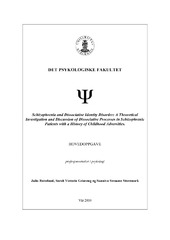Schizophrenia and Dissociative Identity Disorder: A Theoretical Investigation and Discussion of Dissociative Processes in Schizophrenic Patients with a History of Childhood Adversities.
Master thesis
Permanent lenke
https://hdl.handle.net/1956/12082Utgivelsesdato
2016-04-14Metadata
Vis full innførselSamlinger
- Faculty of Psychology [535]
Sammendrag
Research indicates that childhood adversities, which are recognized as an etiological factor in dissociative identity disorder (DID), also are prevalent in patients with schizophrenia. Early descriptions of schizophrenia resemble definitions and descriptions of dissociation, a cardinal feature of DID. Dissociation is defined as a lack of integration of personality due to traumatic experiences in childhood. This theoretical paper investigates dissociative processes in schizophrenic patients with a history of childhood adversities. Relevant literature on DID and schizophrenia is reviewed. It is discussed whether positive symptoms, memory impairments, and disordered self- experience in schizophrenic patients can be understood as dissociative processes. Similarities in neurobiological alterations between schizophrenic patients and people exposed to childhood adversities support the assumption of dissociative processes in the pathology and symptom expression of schizophrenia. A dissociative subtype of schizophrenia has been suggested. The paper advocates a need for the consideration of dissociative processes as a consequence of childhood adversities in schizophrenia. Implications for treatment are discussed. Forskning viser at forekomsten av barndomstraumer, som er en anerkjent årsaksfaktor i dissosiativ identitetsforstyrrelse (DID), også er utbredt blant pasienter med schizofreni. Tidlige beskrivelser av schizofreni ligner definisjoner og beskrivelser av dissosiasjon, et sentralt symptom i DID. Dissosiasjon defineres som manglende integrering av personligheten som følge av traumatiske hendelser i barndommen. Med utgangspunkt i relevant litteratur om DID og schizofreni er formålet med oppgaven å undersøke dissosiative prosesser hos schizofrene pasienter som har opplevd barndomstraumer. Det diskuteres hvorvidt positive symptomer, hukommelsesvansker og forstyrrelser i selv-opplevelse hos schizofrene pasienter kan forstås som dissosiative prosesser. Antakelsen om underliggende dissosiative prosesser i patologi og symptomuttrykk i schizofreni støttes av likheter i nevrobiologiske endringer hos schizofrene pasienter og mennesker som har vært utsatt for barndomstraumer. En dissosiativ subtype av schizofreni er foreslått. Oppgaven argumenterer for at man bør vurdere hvorvidt dissosiative prosesser, utviklet som en konsekvens av barndomstraumer, er tilstede hos schizofrene pasienter. Kliniske implikasjoner drøftes.
Utgiver
The University of BergenOpphavsrett
Copyright the Author. All rights reservedBeslektede innførsler
Viser innførsler beslektet ved tittel, forfatter og emneord.
-
Magnetic Resonance Imaging of Methane Hydrate Formation and Dissociation in Sandstone with Dual Water Saturation
Almenningen, Stian; Fotland, Per; Ersland, Geir (Peer reviewed; Journal article, 2019-08-22)This paper reports formation and dissociation patterns of methane hydrate in sandstone. Magnetic resonance imaging spatially resolved hydrate growth patterns and liberation of water during dissociation. A stacked core ... -
Visualization and interpretation of methane hydrate growth and dissociation in synthetic porous media
Flatlandsmo, Josef (Master thesis, 2015-12-22)Sedimentary natural gas hydrates might play an important role in the future energy mix and the impact of methane release from natural gas hydrates can be significant also with respect to climate change. Vast amounts of ... -
Theoretical studies of CO2 hydrates formation and dissociation in cold aquifers using RetrasoCodeBright simulator
Jemai, Khaled; Kvamme, Bjørn; Vafaei, Mohammad Taghi (Peer reviewed; Journal article, 2014)Abstract: - Hydrates of CO2 and water can form during aquifer storage if the reservoir has regions where conditions of pressure and temperature are inside the hydrate forming conditions. A very common assumption is that ...
